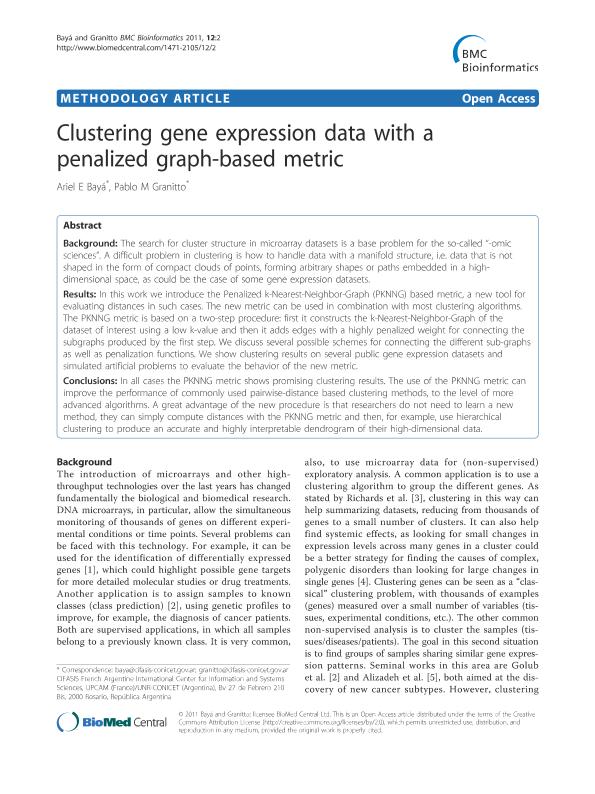Mostrar el registro sencillo del ítem
dc.contributor.author
Baya, Ariel Emilio

dc.contributor.author
Granitto, Pablo Miguel

dc.date.available
2017-04-11T20:56:52Z
dc.date.issued
2011-01
dc.identifier.citation
Baya, Ariel Emilio; Granitto, Pablo Miguel; Clustering gene expression data with a penalized graph-based metric; Biomed Central; Bmc Bioinformatics; 12; 2; 1-2011; 1-18
dc.identifier.issn
1471-2105
dc.identifier.uri
http://hdl.handle.net/11336/15184
dc.description.abstract
Background: The search for cluster structure in microarray datasets is a base problem for the so-called “-omic sciences”. A difficult problem in clustering is how to handle data with a manifold structure, i.e. data that is not shaped in the form of compact clouds of points, forming arbitrary shapes or paths embedded in a highdimensional space, as could be the case of some gene expression datasets.
Results: In this work we introduce the Penalized k-Nearest-Neighbor-Graph (PKNNG) based metric, a new tool for evaluating distances in such cases. The new metric can be used in combination with most clustering algorithms. The PKNNG metric is based on a two-step procedure: first it constructs the k-Nearest-Neighbor-Graph of the dataset of interest using a low k-value and then it adds edges with a highly penalized weight for connecting the subgraphs produced by the first step. We discuss several possible schemes for connecting the different sub-graphs as well as penalization functions. We show clustering results on several public gene expression datasets and simulated artificial problems to evaluate the behavior of the new metric.
Conclusions: In all cases the PKNNG metric shows promising clustering results. The use of the PKNNG metric can improve the performance of commonly used pairwise-distance based clustering methods, to the level of more advanced algorithms. A great advantage of the new procedure is that researchers do not need to learn a new method, they can simply compute distances with the PKNNG metric and then, for example, use hierarchical clustering to produce an accurate and highly interpretable dendrogram of their high-dimensional data.
dc.format
application/pdf
dc.language.iso
eng
dc.publisher
Biomed Central

dc.rights
info:eu-repo/semantics/openAccess
dc.rights.uri
https://creativecommons.org/licenses/by-nc-sa/2.5/ar/
dc.subject
Clustering
dc.subject
Isomap
dc.subject
Gene Expression
dc.subject.classification
Ciencias de la Información y Bioinformática

dc.subject.classification
Ciencias de la Computación e Información

dc.subject.classification
CIENCIAS NATURALES Y EXACTAS

dc.title
Clustering gene expression data with a penalized graph-based metric
dc.type
info:eu-repo/semantics/article
dc.type
info:ar-repo/semantics/artículo
dc.type
info:eu-repo/semantics/publishedVersion
dc.date.updated
2017-04-11T17:42:08Z
dc.journal.volume
12
dc.journal.number
2
dc.journal.pagination
1-18
dc.journal.pais
Reino Unido

dc.journal.ciudad
Londres
dc.description.fil
Fil: Baya, Ariel Emilio. Consejo Nacional de Investigaciones Científicas y Técnicas. Centro Científico Tecnológico Rosario. Centro Internacional Franco Argentino de Ciencias de la Información y Sistemas; Argentina. Universidad Nacional de Rosario; Argentina
dc.description.fil
Fil: Granitto, Pablo Miguel. Consejo Nacional de Investigaciones Científicas y Técnicas. Centro Científico Tecnológico Rosario. Centro Internacional Franco Argentino de Ciencias de la Información y Sistemas; Argentina. Universidad Nacional de Rosario; Argentina
dc.journal.title
Bmc Bioinformatics

dc.relation.alternativeid
info:eu-repo/semantics/altIdentifier/doi/http://dx.doi.org/10.1186/1471-2105-12-2
dc.relation.alternativeid
info:eu-repo/semantics/altIdentifier/url/https://bmcbioinformatics.biomedcentral.com/articles/10.1186/1471-2105-12-2
dc.relation.alternativeid
info:eu-repo/semantics/altIdentifier/url/https://www.ncbi.nlm.nih.gov/pmc/articles/PMC3023695/
Archivos asociados
